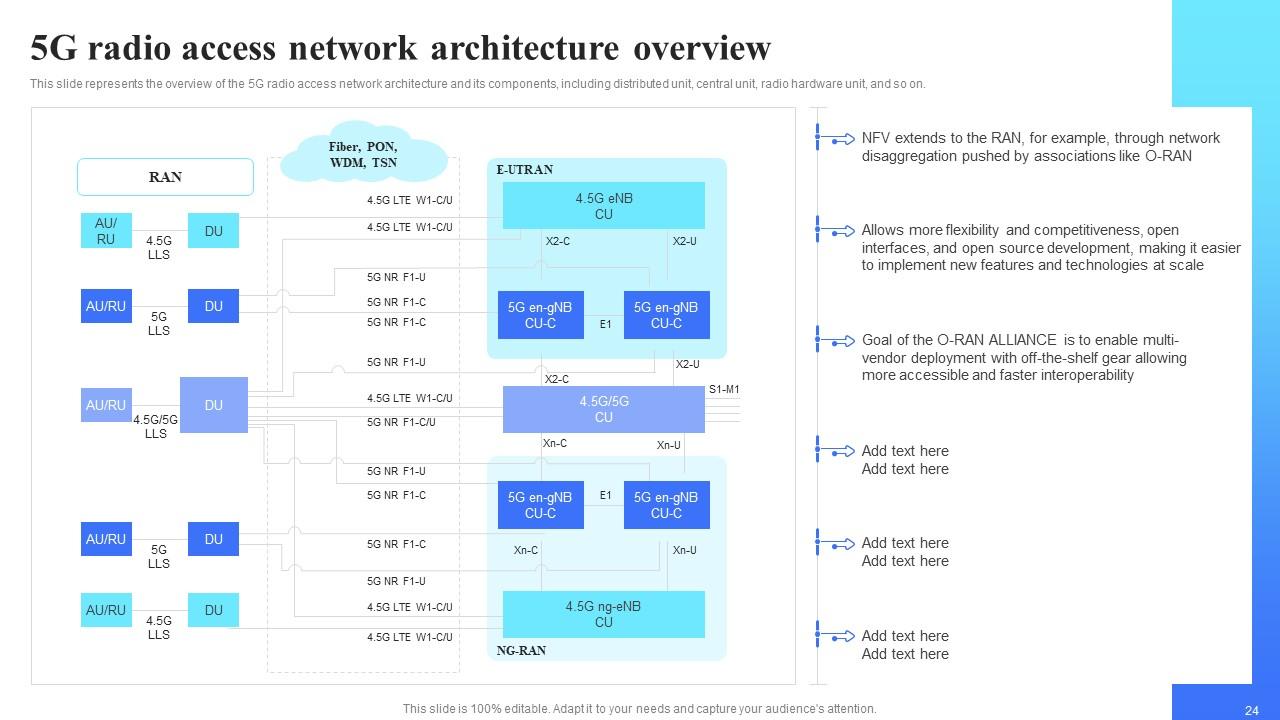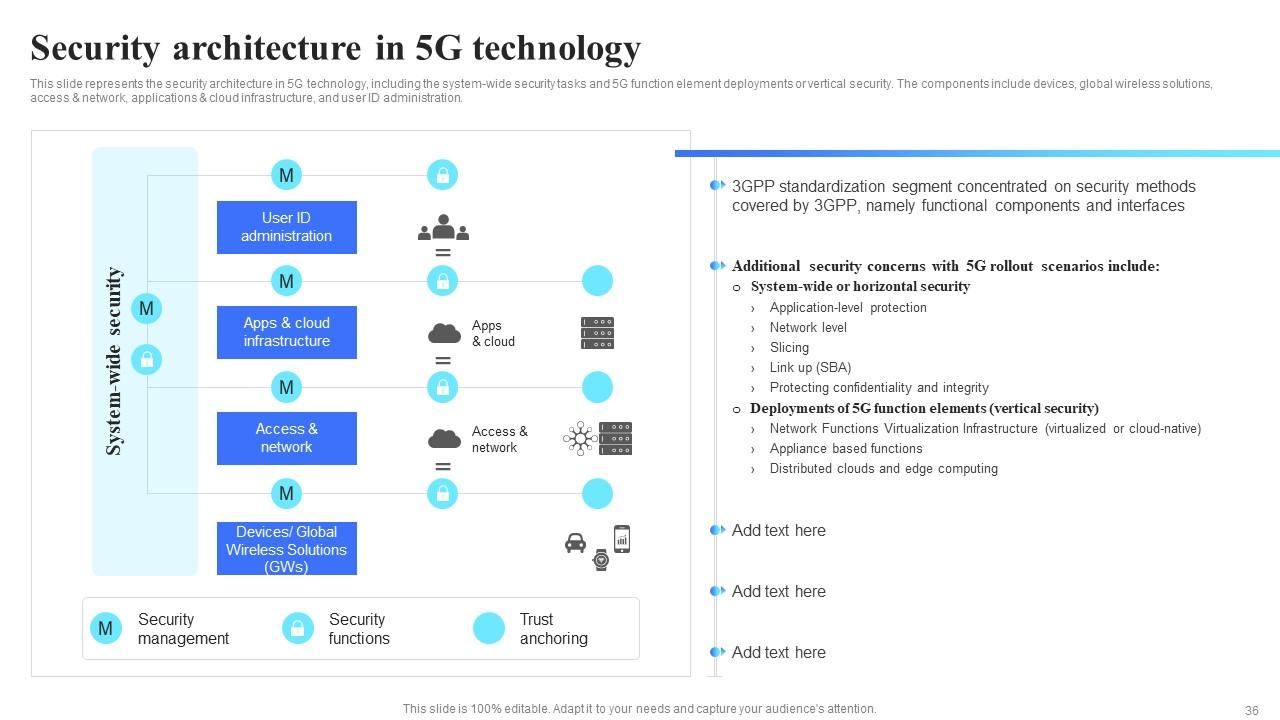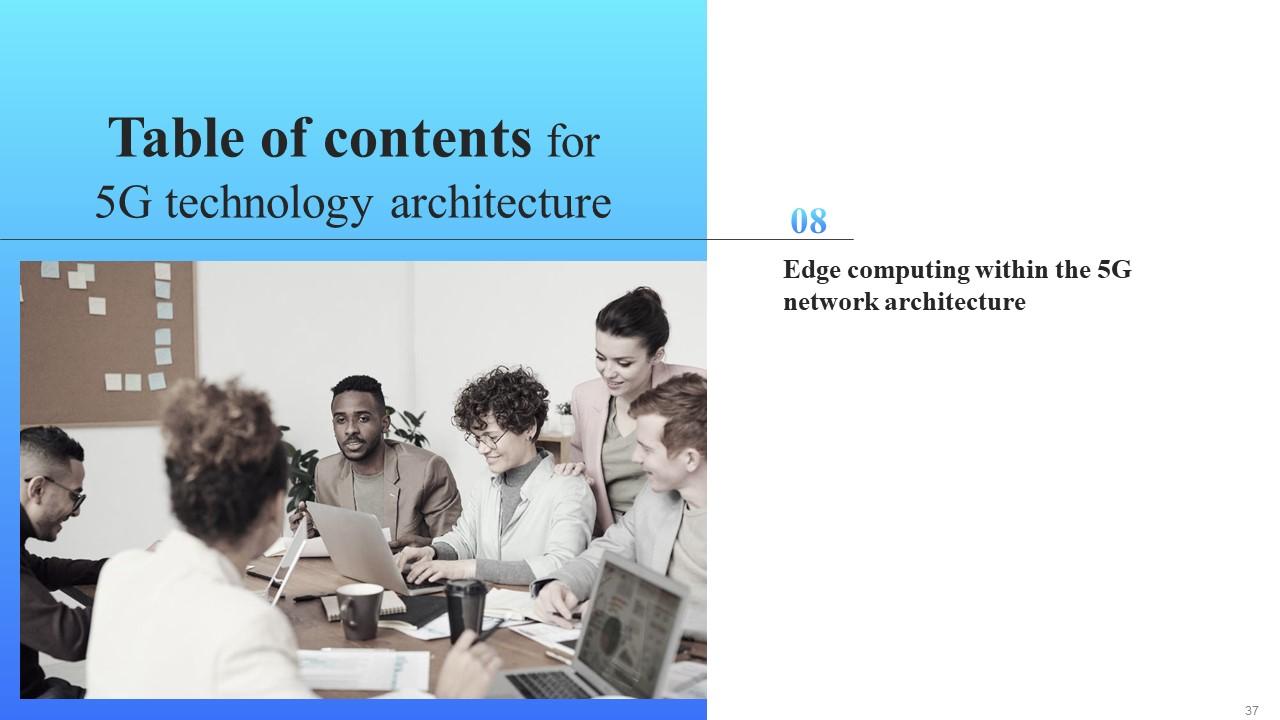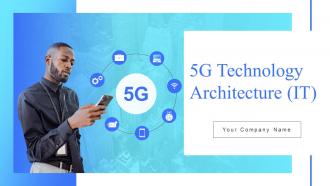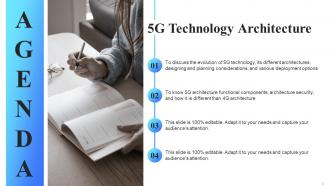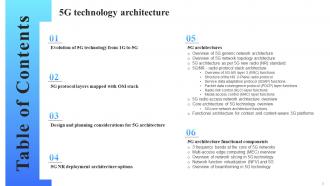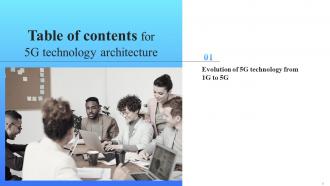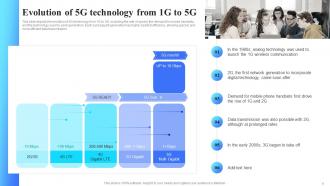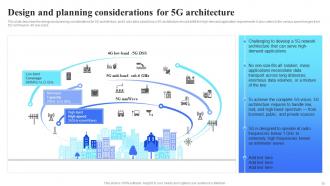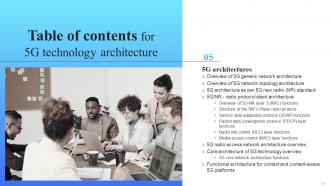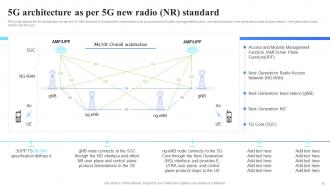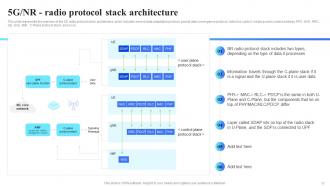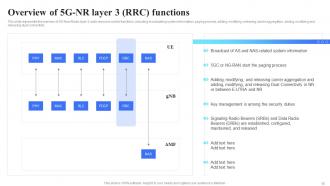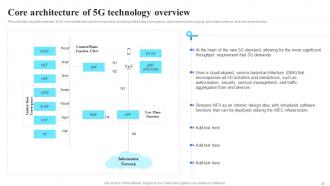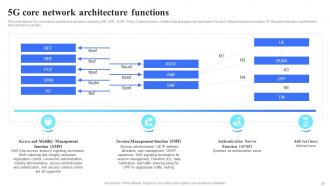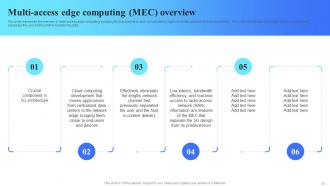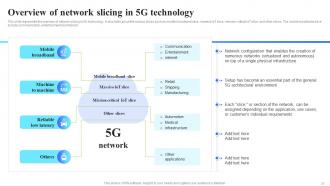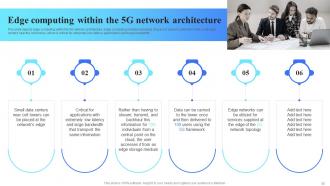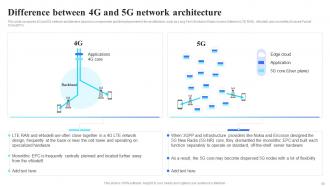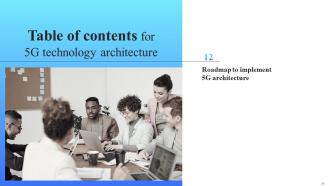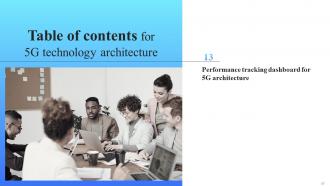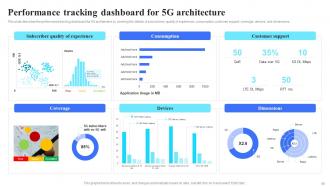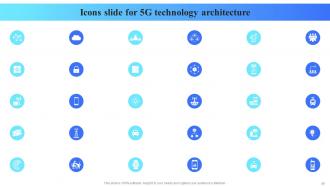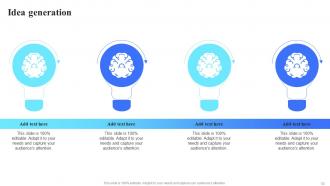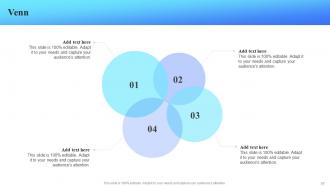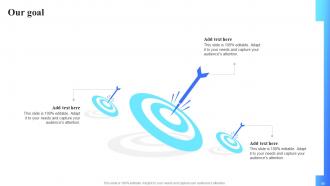5G Technology Architecture Powerpoint Presentation Slides
The 5G wireless technology improves efficiency and effectiveness by delivering higher peak data rates of several Gbps. Grab our insightfully crafted 5G Technology Architecture template. It provides a quick overview of the structure and operation of 5G technology and the transition from 1G to 5G. Our 5G Generic Architecture slide includes the OSI stack mapping for the 5G protocol levels, design and planning concerns, and deployment alternatives. The several types of 5G architectures, like the 5G generic network, etc., are covered in the PowerPoint presentation. Additionally, it shows how NR RRC, NR U-plane, SDAP, PDCP, RLC, and MAC Layers operate. The 5G radio access network, its core architecture, and functional architecture for context and content aware 5G platforms are also included in the PPT. It further comprises the elements of the 5G architecture, including the beamforming technology used in 5G, MEC, network slicing, and many more. Additionally, our 5G NR Standard Architecture module illustrates how edge computing fits into the 5G network design and how it differs from 4G. Lastly, it caters to a timeline, a roadmap to implement 5G architecture, and a performance tracking dashboard for 5G architecture. Get access now.
You must be logged in to download this presentation.
 Impress your
Impress your audience
Editable
of Time
PowerPoint presentation slides
Deliver this complete deck to your team members and other collaborators. Encompassed with stylized slides presenting various concepts, this 5G Technology Architecture Powerpoint Presentation Slides is the best tool you can utilize. Personalize its content and graphics to make it unique and thought-provoking. All the fifty nine slides are editable and modifiable, so feel free to adjust them to your business setting. The font, color, and other components also come in an editable format making this PPT design the best choice for your next presentation. So, download now.
People who downloaded this PowerPoint presentation also viewed the following :
Content of this Powerpoint Presentation
Back in the day, the days of “old folks” where connectivity was not for any reason but device flexibility and acceptance had to struggle. Today, with 5G technology slowly gaining traction, the future of networking is not only secure with 5G but guaranteed. With 5G, industrial applications are endless, apart from creating free roads and implementing an effective telemedicine network in hostile territories that are difficult to access.
It may not be easy to understand modern technology, let alone a complex and dense one like 5G, yet SlideTeam’s 5G Technology Architecture PowerPoint Slides make it easier.
Whether you are an experienced technician wanting to keep ahead of other people in practice or just an enthusiastic student willing to know more about this innovative phenomenon, our slides will guide you.
What You Will Get
The template covers the basics of 5G architecture, which are an introduction into 5G, 5G Protocol Stack, mapping of 5G protocols with OSI stack, design consideration, conclusion and deployment strategy, and many more.
It provides an in-depth review and explanation of 5G network elements. In particular, generic, context management, subscribers, 5G-supported service, 5G RRC, NR U-plane and NR C-plane architecture, SDAP, PDPC, RLC, and MAC Layers, and the deployment of 5G architecture from radio access to the core are examined. In the end, it identifies key ingredients that go into 5G.
Explore how Slide Team’s 5G Technology Architecture PowerPoint Presentation Slides is your journey to start a technological revolution or update with the right tools. The templates are 100% editable and customizable as well.
Discover our blog on Building 5G Wireless Mobile Network PowerPoint presentation Slides to learn about 5G in detail.
Template 1 - Evolution of 5G technology from 1G to 5G

This slide showcases the transition of mobile communication technologies from 1G to the current 5G. It also illustrates improvements in speed, mobile handsets, and technology over the generations. The slide demonstrates how spectral efficiency has increased as each generation comes with increased capabilities. Noteworthy, 1G technology could only support voice communication. However, the current 5G technology is capable of supporting voice, data, and other multimedia across 4G and 5G stations. This slide is the premise for appreciating the improvement that 5G technology has created.
Template 2 - 5G protocol layers mapped with OSI Stack
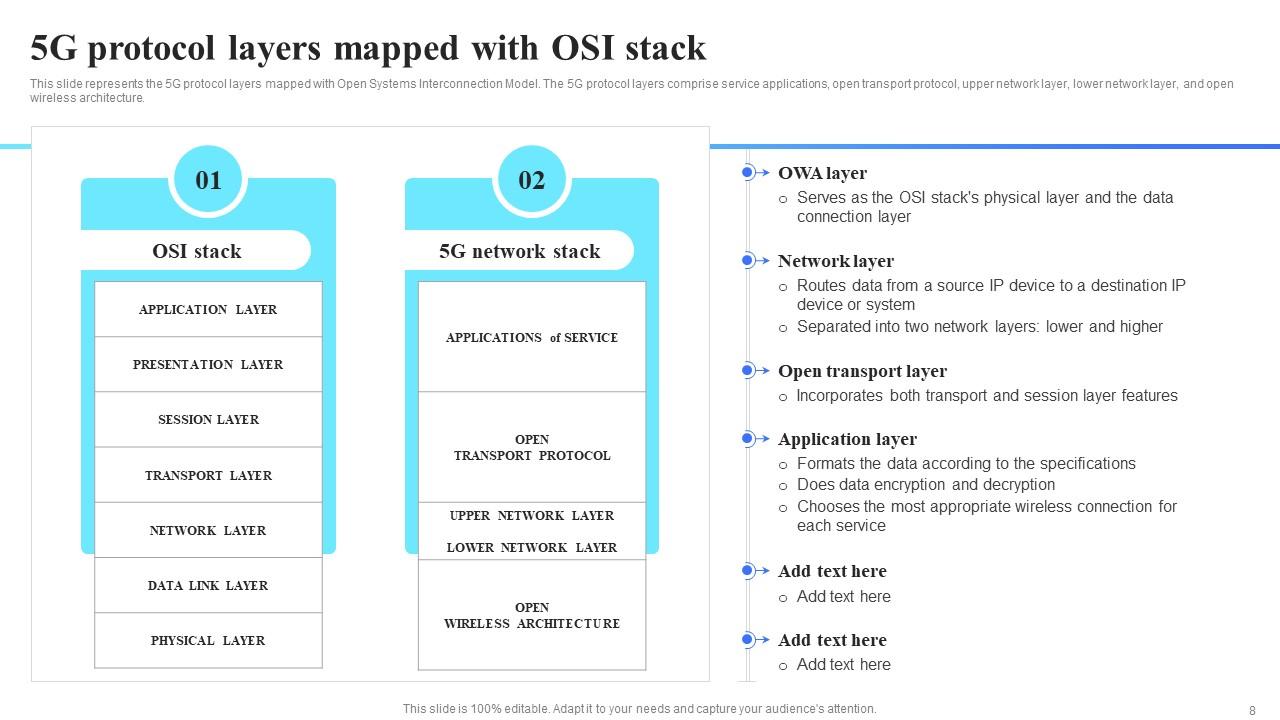
The given slide introduces a full spectrum of 5G protocol layers that are graphed per the Open Systems Interconnection (OSI) model. Such an approach identifies the application, presentation, sessions, transport, network, data link, and physical layer. By doing so, the slide allows the discovery of 5G protocol layers in connection with the OSI Stack. Service application, service network, service data unit security, and open wireless architecture designs are the layers, and particular attention should be paid to each role.
Template 3 - Design and planning considerations for 5G architecture

The slide provides details on the design and planning principles needed to create robust 5G architecture. It discusses the importance of incorporating high-demand application needs in an appropriate framework. Another aspect is the concept of speed ranges that 5G technologies possess, from low to high, such as the ultra-fast capacity of 5G mmWave, which provides up to 10 Gbps1, or the broader coverage of 4G Low band 30, which can be limited even more in rural areas; with these details, the stakeholders should be able to plan how to deploy their networks to satisfy all cross-sections of users.
Template 4 - 5G NR deployment architecture options
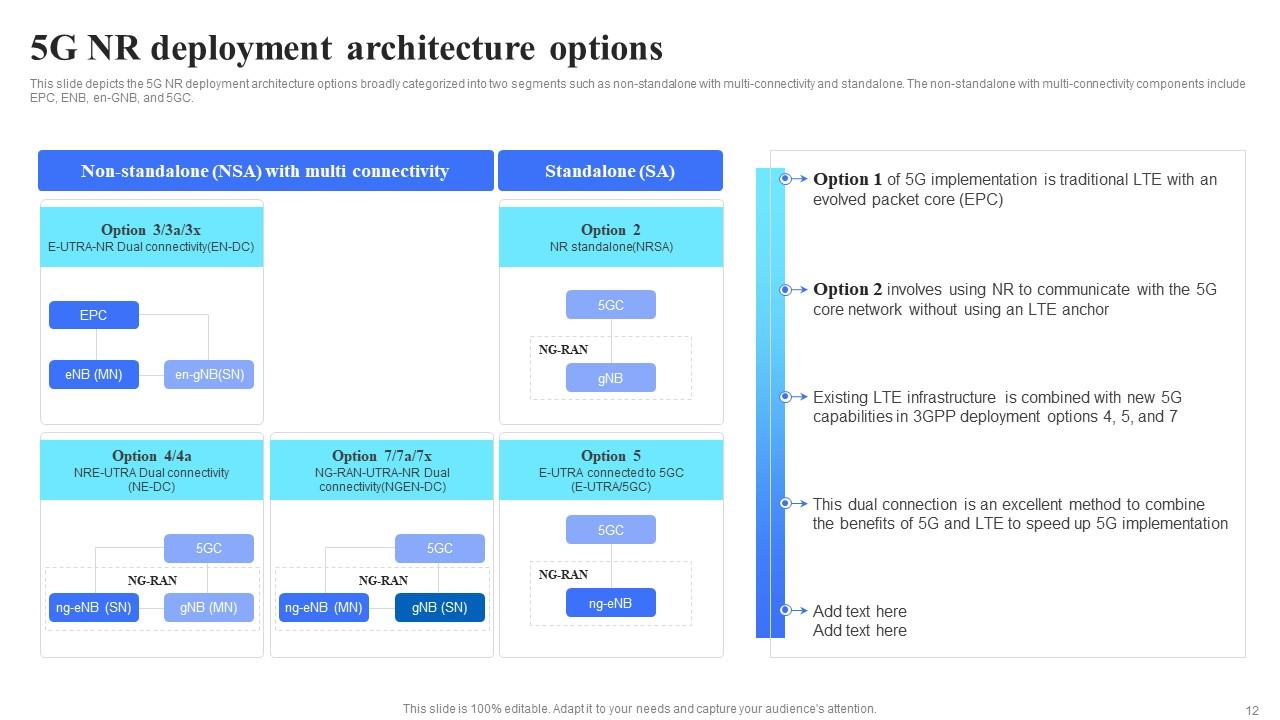
This slide shows the available deployment architecture options for 5G New Radio. The alternatives are organized into two sections, including the standalone and non-standalone configurations. For the standalone choice, it is possible to use the 5G Core and Next-Generation NodeB, which are self-sufficient. On the other hand, in the non-standalone options, it is possible to deploy such elements as the Evolved Packet Core, Radio NodeB, Enhanced NodeB, and Enhanced NodeB High Band. In addition, the 5GC and gNB are used for multi-connectivity purposes.
Template 5 - Overview of the 5G generic network architecture

This slide addresses the generic network architecture of 5G technology. One can see the key components that are vital for the operation of 5G cell phones, GSM, LTE, Wi-Fi, aggregators, the IP network infrastructure, the billing system, nanocore, and global content providers. The slide allows for an understanding of which network elements are interconnected and which serve as a link for implementing connectivity in the 5G age. The visual slide can serve as a reference for the network’s planning, deployment, and optimization, helping stakeholders make informed decisions.
Explore our blog on the Evolution of Wireless Telecommunication from 1G to 5G powerpoint slides in detail.
Template 6 - Overview of the 5G network topology architecture

This slide provides an understanding of the architecture and topology of 5G networks, outlining essential components and functionalities. This section highlights critical elements, including Network Exposure Function (NEF), Mobility Management, Session Management Function (SMF), User Equipment (UE), Network Repository Function (NRF), Policy Control Function (PCF), User Plane Function (UPF) and Unified Data Management. The idea is to get clarity on how 5G networks are structured and how seamless data management and seamless communication are provided.
Template 7 - 5G architecture as per 5G new radio standard

The slide presents a detailed outline of the 5G architecture aligned with the 5G New Radio standard. It presents a list of core components that are necessary to deploy and maintain a 5G network, including the Access and Mobility Management Function, User Plane Function, Next-Generation Radio Access Network, Next-Generation Base Station, and 5G Core. By listing these components, the slide provides a structured description of the essential parts making up a 5G system. This slide can be seen as a knowledge resource for engineers, architects, and stakeholders who will have to work with 5G networks, organizing and guiding their efforts for successful implementation and optimal performance.
Template 8 - 5G/NR radio protocol stack architecture

This PPT Template provides picture of the architecture of the 5G NR protocol stack. The presented picture demonstrates the implementation of the radio communication system and suggests a realization of the protocol stack, including the DSS and the BSS approaches. The slide is helpful because it identifies the components necessary to make the radio communication system work. For instance, there is a Service Data Adaptation Protocol, a Packet Data Convergence Protocol, Radio Link Control or even a Media Access Control Address. Thus, while reading this slide, one could understand the ideas that are serving the benefit of more effective data transmission and network operation for data.
Template 9- Overview of 5G - NR layer 3 (RRC) Functions

This slide takes note of the central operational aspects essential to optimal radio resource management. The activities depicted on the slide are the broadcasting of system information for connected users and the paging of subscribers when data for them is ready. The PowerPoint also speaks of tasks involved in adding, modifying, and releasing carrier aggregation activity. Another central point relates to operations necessary for adding, modifying, and releasing dual connectivity. Overall, the slide describes the complex and nuanced activities that govern radio resource allocation and optimization.
Template 10 - Structure of the NR U-Plane Radio Protocol

The slide shows an informative representation of the Layer 2 structure of the New Radio (NR) U-Plane protocol, both for the downlink and uplink. Namely, it depicts the components of Layer 2 required for efficient data transfer, which are the Service Data Adaptation Protocol, Packet Data Convergence Protocol, Radio Link Control, Physical layer, and Medium Access Control. Importantly, it illustrates the layered structure that regulates data transfer in the U-Plane of a 5G NR network. As such, it is helpful for network engineers and operators, as it allows them to understand the protocols involved and how they contribute to making U-Plane more effective.
Explore the Power of 5G With Us
In hindsight, the arrival of 5G technology will revolutionize how we interact with technology. The stack doesn’t finish here; it gives insight into how the technology is implemented. Some of the slide elements contain practical tips to create, but on the whole, it is a ready-to-use-action plan, including a roadmap and performance tracking tools.
PS Look out for our blog on the 6-month roadmap for the 5G communication timeline to understand the technology in detail.
5G Technology Architecture Powerpoint Presentation Slides with all 64 slides:
Use our 5G Technology Architecture Powerpoint Presentation Slides to effectively help you save your valuable time. They are readymade to fit into any presentation structure.
-
Enough space for editing and adding your own content.
-
“Excellent information with easy access.”
















